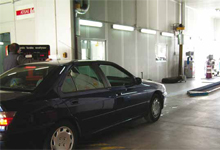 |
| The AXIS 211 cameras offer excellent image quality thanks to their sensor with progressive scan technology |
The Technical Vehicle Inspection is a service that aims to reduce the incidence of accidents by mechanical failures in road safety. The purpose of these inspections is to verify that the general condition, such as vehicle safety features, meet the requirements that allow it to circulate without posing a danger to its occupants, other road users or the environment, and to control the level of pollutant emissions from motor vehicles. The content and the protocols of the tests done in Technical Vehicle Inspection stations are regulated by the European Union.
For Spain, most of the autonomous communities have received the responsibility for Technical Vehicle Inspections. ATISAE began Technical Vehicle Inspections in May 1982 at the Technical Vehicle Inspection station of Albacete, as "the first private entity to develop the activity in the field of Technical Vehicle Inspection." Since then it has continued to develop its activity in this field, and at present it owns sixteen Technical Vehicle Inspection centres.
Since 1985, it is mandatory that all vehicles registered in the Spanish territory are subject to regular technical inspection to verify their condition. The enforcement of Royal Decree 224/2008 marked the completion of a series of changes in the Technical Vehicle Inspection centres, because, among other changes, pursuant to this new law, each station had to justify the passage of vehicles through the inspection line by license plate scanning or by any other audiovisual method, and archive those images with the rest of the data and results from each inspection.
ATISAE selected the AXIS 211 with a protective housing, since it is used in open vessels and in an atmosphere with carbon dioxide pollution |
However, the proposals received amounted to a major investment. Given that ATISAE has a large information systems department and a significant number of Technical Vehicle Inspection centres located throughout the Spanish territory, it considered the possibility of developing this tool internally. This prompted a search for license plate recognition software vendors, and ATISAE contacted Axis' partner Neural Labs, which provided the VPAR (Automatic Vehicle Plate Reader) product, a software library for applications requiring Automatic License Plate Recognition, which integrates immediately with the Axis network cameras. ATISAE systems department integrated this software and the images from the AXIS 211 network cameras with the Technical Vehicle Inspection file generation application. The high programming capabilities and integration of the network cameras were key features when selecting this technology.
Technical Vehicle Inspection centres carry a high degree of computerisation and measurement equipment based on IP networks, therefore, using an analogue video system was ruled out since it involves the installation of additional equipment incompatible with other applications. After performing various tests on a pilot Technical Vehicle Inspection station, it was decided to incorporate one or two Axis network cameras per inspection line (representing an average of about six to eight cameras per each Technical Vehicle Inspection centre), which can take pictures of vehicles passing through it and can be activated manually, via sensors, or via a magnetic loop. After all the precise parameters were defined and tested (bear in mind that the position of the license plate is different for cars, vans, motorcycles and tractors, for example), the installation was replicated in the remaining fifteen ATISAE Technical Vehicle Inspection establishments.
Solution
ATISAE initially sought a solution that would automate the inclusion of one or more images of the license plate of each vehicle inspected in the electronic record generating system and called for bids from suppliers with whom it works on a regular basis.
Result
They selected the AXIS 211 with a protective housing, since it is used in open vessels (sometimes enduring extreme temperatures) and in an atmosphere with CO2 pollution. The AXIS 211 cameras offer excellent image quality thanks to their sensor with progressive scan technology. They have found that the use of network cameras also helps with issues of surveillance and some Technical Vehicle Inspection centres have installed other network cameras from Axis for outdoor use to fill this security need and also for other uses such as controlling waiting vehicle lines. ATISAE continues its expansion process in the Technical Vehicle Inspection business and in the event that it obtains new concessions, its centres will incorporate this vehicle license plate image capturing system based on IP cameras.
















